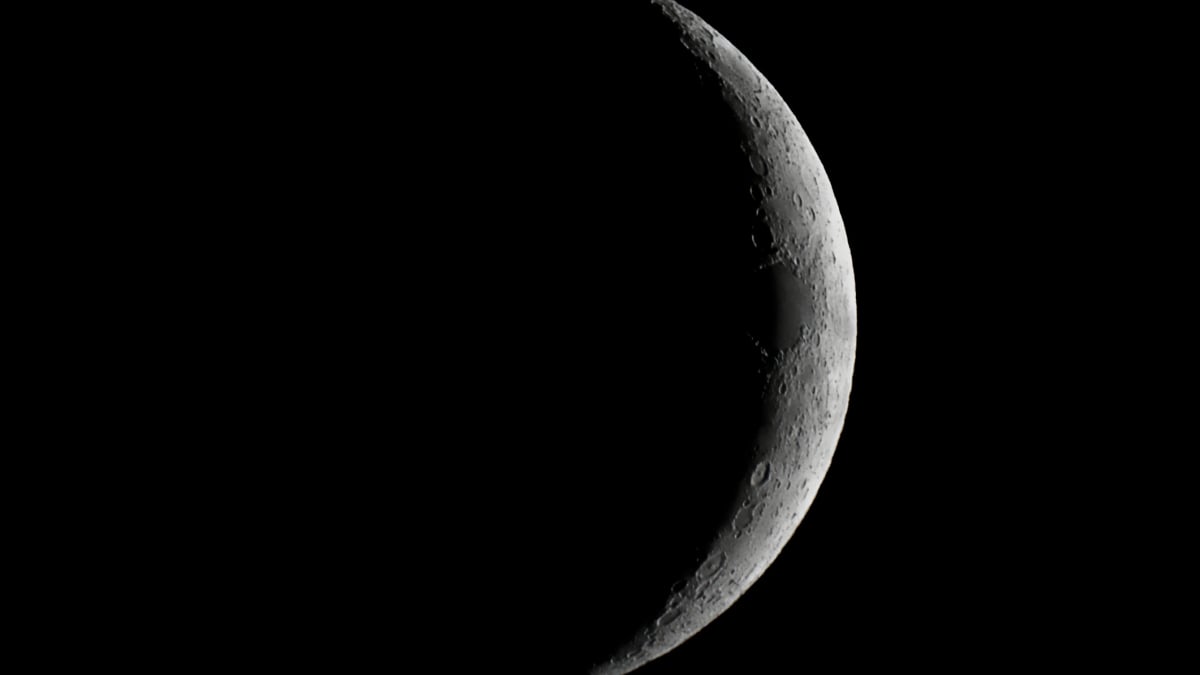Entertainment
The plan to build a telescope the size of Washington, D.C., on the moon

The concept of a city-sized telescope on the moon has piqued NASA‘s interest.
The space agency recently awarded(opens in a new tab) researchers a grant to further develop the plan for a sprawling array of antennae on the moon’s cryptic far side — using minerals mined from the moon. At this stage of the game, a proposal for a 77-square-mile telescope snaking over the lunar surface is an idea, not nearly a funded endeavor. But such a radio telescope, called the FarView Observatory, would allow astronomers to see what no other instrument today can: A period of time before the stars, called the universe’s “Dark Ages.”
“I’ve personally been advocating for a radio telescope on the moon for 40 years now,” Jack Burns, a professor in the Department of Astrophysical and Planetary Sciences at CU Boulder who’s a member of the FarView project, told Mashable. “It’s going to probe a part of the universe we haven’t been able to see before.”
Radio telescopes have a lot in common with the radio antenna on your car. But they’re not tuning into The Rolling Stones and Metallica. Radio telescopes — often built as giant dishes — capture radio waves emanating through the cosmos from exploding stars, forming stars, black holes, and beyond. Radio telescopes have to be big, because radio waves from the deep universe are extremely weak sources of energy. (“These are very faint signals. The amount of energy collected in radio astronomy’s history is less than the energy needed to melt a snowflake,” Yvette Cendes, an astronomer and postdoctoral fellow at the Harvard-Smithsonian Center for Astrophysics(opens in a new tab), told Mashable earlier this year.)
But the radio telescope arrays on Earth, as vast as they are(opens in a new tab), receive too much interference to pick up the faintest signals in the universe. A lofty part of our atmosphere, called the ionosphere, reflects extremely distant and stretched-out radio waves. And then, there’s us. “Random radio emissions from our noisy civilization can interfere with radio astronomy as well, drowning out the faintest signals,” NASA explains(opens in a new tab).
“It’s going to probe a part of the universe we haven’t been able to see before.”
A telescope on the moon’s dark far side, however, is free of this noise. There’s little to no lunar atmosphere. And the moon itself blocks pesky radio waves from our boisterous planet.
On the moon’s far side, there’s a (relatively) clear view into the deepest of the cosmos. All we need is an extremely large telescope.

A conception of the FarView radio telescope on the moon’s surface. The metallic lines are what make up the telescope’s antennae.
Credit: Ronald Polidan
Building a city-sized telescope
The idea is indeed hugely ambitious. But perhaps not as far-fetched as it sounds.
NASA is funding the further conceptual development of FarView, proposed by the aerospace company Lunar Resources, through its “NASA Innovative Advanced Concepts” program. At this Phase II round, researchers receive up to $600,000 to advance their ideas. Also included in this year’s recipients is a planetary defense endeavor that would “pulverize” an incoming asteroid or comet, an “astropharmacy” to make needed drugs (for radiation exposure and other ailments) in deep space, and a fast-moving spacecraft powered by a “radioisotope electric propulsion system,” among other concepts.
A major selling point for the sprawling lunar observatory, emphasizes Burns, is that nearly all the metallic materials are available on the moon. Giant, expensive rockets won’t need to haul bounties of conducting metal for the antennae.
“We don’t have to bring all that material from Earth,” Burns said. “We can in fact build an array with 100,000 antennas with only a few flights to the moon.”
“In some ways, this is 1950s technology.”
Similar to a giant spiderweb laid on the ground, robotic rovers would lay strips of aluminum extracted from the lunar soil on relatively flat expanses of the moon (as shown in the graphic above). These thin metal strips act like the metal rods or wires commonly seen in antennas, which catch radio signals traveling by (just like your car’s antenna).
“In some ways, this is 1950s technology,” Burns marveled.
Yet the radio waves Burns and other astronomers hope to catch on the moon are quite long, at some 20, 30, or more meters. (FM radio waves are some 3 meters long.(opens in a new tab)) The universe is constantly expanding, and the different types of light (visible light, infrared light, X-rays, radio waves, and beyond) is stretched out as space expands. That’s a critical reason why an observatory that seeks some of the oldest signals in the cosmos must be so big: The radio waves have been stretched like taffy.
Of course, the greater telescope project will require more than mining aluminum from the moon’s soil. A swarm of robotic rovers will need to lay the wiring. Solar panels must be constructed to power the machines. And some level of human oversight will be required, perhaps from astronauts who will inhabit the Lunar Gateway, an outpost that will orbit the moon(opens in a new tab).

A conception of a rover as part of the FarView telescope construction process.
Credit: Ronald Polidan
A colossal looming question, of course, is cost. NASA is considering other large-scale lunar telescope(opens in a new tab) ideas. But cutting the transportation of metals to the moon is a great boon for such an expansive project. And with the rise and success of commercial rockets, any necessary launch costs are falling. Overall, it’s too early to know the bill for such a sprawling telescope. But it will almost certainly be billions.
NASA and Congress, however, have been historically committed to spending billions on scientific endeavors into how the universe formed, and where we and the Milky Way galaxy came from. The James Webb Space Telescope(opens in a new tab) cost taxpayers nearly $11 billion(opens in a new tab) – with much of it built and assembled in the U.S. Other scientific endeavors, like the Mars Perseverance rover, cost some $2.7 billion(opens in a new tab). And the first launches of NASA’s new megarocket, the Space Launch System, will cost over $4 billion per launch, as it supports exploration and scientific endeavors on the moon.
A project like FarView might be especially enticing to NASA, noted Burns, because it would advance robotic exploration and industrial creation on another world. The space agency wants to establish a permanent presence on and around the moon. And it wants to go to Mars. For such deeper space endeavors it will need proven building and industrial technology. “NASA is interested in the technology and engineering along with the science,” said Burns, speaking of FarView.
A price tag for constructing a sprawling array of metallic rods on the moon won’t be cheap. But it could be reasonable, considering the scope of the project. And the returns could be scientifically, and technologically, invaluable.
“It would be the biggest telescope ever built — and we’re going to do it using robots,” Burns said.
Want more science and tech news delivered straight to your inbox? Sign up for Mashable’s Top Stories newsletter today.

As this graphic shows on the left, radio waves travel in the longest waves compared to other types of radiation (like visible light and beyond).
Credit: NASA
How to peer into the universe’s Dark Ages
NASA’s pioneering Webb space telescope can see some of the earliest galaxies ever formed, around 300 million years after the Big Bang. A giant radio telescope like FarView would peer beyond this early period.
The “Dark Ages” had began just some 370,000 years after the universe was born. By this time, the cosmos had cooled and the first atoms, hydrogen, had formed. There were no stars, and wouldn’t be for hundreds of millions of years, astronomers say.
Yet the cosmos were flooded with clouds of hydrogen, which emanate energy via radio waves. This is what a telescope on the far side of the moon would view.

The history and expansion of the universe. The Dark Ages happened soon after the universe had began.
Credit: NASA / WMAP Science Team
Amid the Dark Ages, astronomers could now see — for the first time — how large clumps of gas ultimately formed the first, extremely hot stars. “They were 30 to 300 times more massive than our sun and millions of times brighter,” NASA explained. Those stars would lead to the very first galaxies long before ours existed.
The Dark Ages wouldn’t be so dark, anymore. But we’ll need a giant telescope. In the coming decades, it could be FarView.
“It’s the ultimate cosmology telescope,” Burns said.
-

 Business6 days ago
Business6 days agoTesla’s new growth plan is centered around mysterious cheaper models
-

 Business5 days ago
Business5 days agoXaira, an AI drug discovery startup, launches with a massive $1B, says it’s ‘ready’ to start developing drugs
-

 Business6 days ago
Business6 days agoUK probes Amazon and Microsoft over AI partnerships with Mistral, Anthropic, and Inflection
-

 Entertainment4 days ago
Entertainment4 days agoSummer Movie Preview: From ‘Alien’ and ‘Furiosa’ to ‘Deadpool and Wolverine’
-

 Business5 days ago
Business5 days agoPetlibro’s new smart refrigerated wet food feeder is what your cat deserves
-

 Business3 days ago
Business3 days agoHow Rubrik’s IPO paid off big for Greylock VC Asheem Chandna
-

 Entertainment3 days ago
Entertainment3 days agoWhat’s on the far side of the moon? Not darkness.
-

 Business4 days ago
Business4 days agoThoma Bravo to take UK cybersecurity company Darktrace private in $5B deal



























